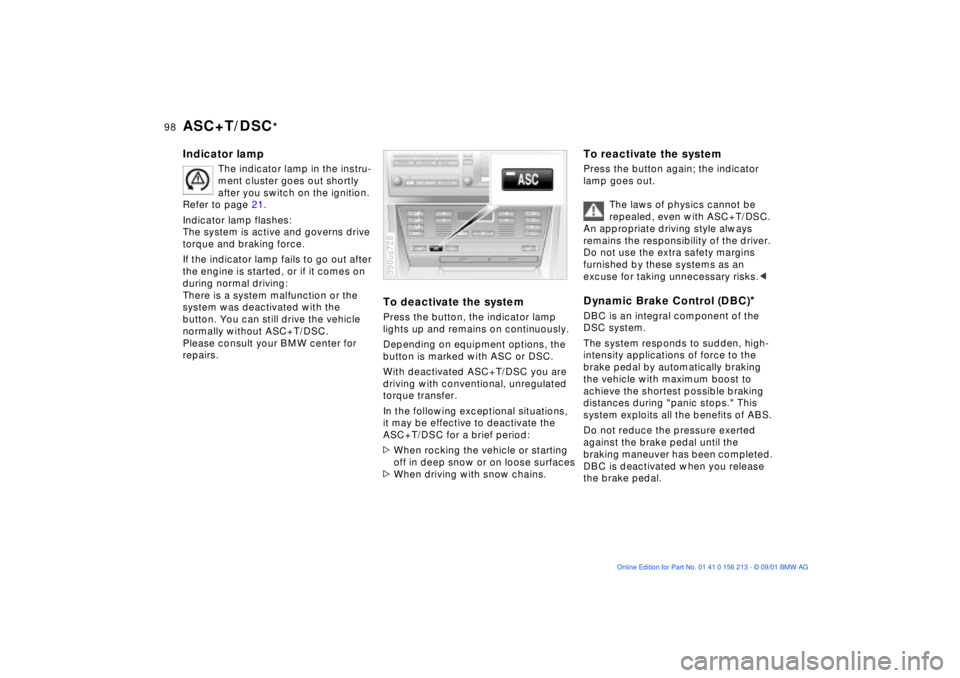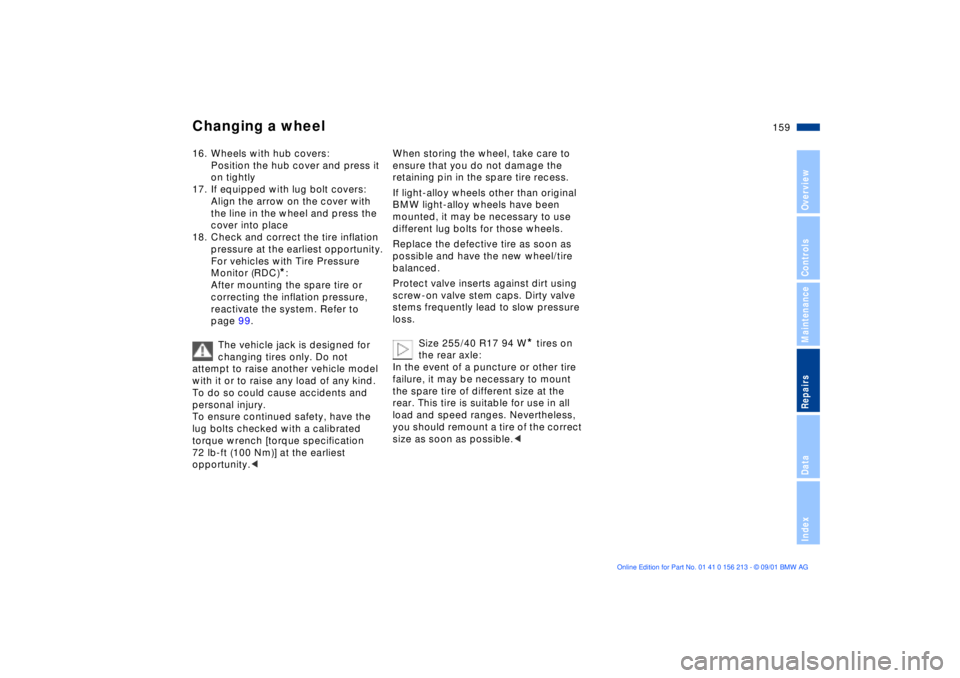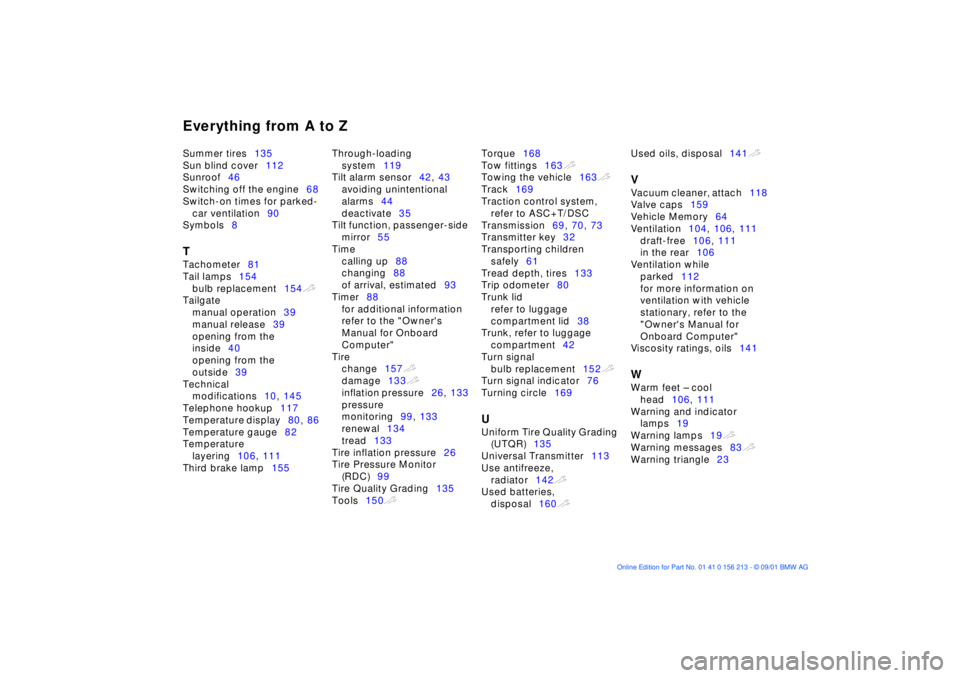Page 98 of 186

98n
ASC+T/DSC
*
Indicator lamp
The indicator lamp in the instru-
ment cluster goes out shortly
after you switch on the ignition.
Refer to page 21.
Indicator lamp flashes:
The system is active and governs drive
torque and braking force.
If the indicator lamp fails to go out after
the engine is started, or if it comes on
during normal driving:
There is a system malfunction or the
system was deactivated with the
button. You can still drive the vehicle
normally without ASC+T/DSC.
Please consult your BMW center for
repairs.
To deactivate the systemPress the button, the indicator lamp
lights up and remains on continuously.
Depending on equipment options, the
button is marked with ASC or DSC.
With deactivated ASC+T/DSC you are
driving with conventional, unregulated
torque transfer.
In the following exceptional situations,
it may be effective to deactivate the
ASC+T/DSC for a brief period:
>When rocking the vehicle or starting
off in deep snow or on loose surfaces
>When driving with snow chains.390us728
To reactivate the systemPress the button again; the indicator
lamp goes out.
The laws of physics cannot be
repealed, even with ASC+T/DSC.
An appropriate driving style always
remains the responsibility of the driver.
Do not use the extra safety margins
furnished by these systems as an
excuse for taking unnecessary risks.< Dynamic Brake Control (DBC)
*
DBC is an integral component of the
DSC system.
The system responds to sudden, high-
intensity applications of force to the
brake pedal by automatically braking
the vehicle with maximum boost to
achieve the shortest possible braking
distances during "panic stops." This
system exploits all the benefits of ABS.
Do not reduce the pressure exerted
against the brake pedal until the
braking maneuver has been completed.
DBC is deactivated when you release
the brake pedal.
Page 159 of 186

159n
OverviewControlsMaintenanceRepairsDataIndex
Changing a wheel16. Wheels with hub covers:
Position the hub cover and press it
on tightly
17. If equipped with lug bolt covers:
Align the arrow on the cover with
the line in the wheel and press the
cover into place
18. Check and correct the tire inflation
pressure at the earliest opportunity.
For vehicles with Tire Pressure
Monitor (RDC)
*:
After mounting the spare tire or
correcting the inflation pressure,
reactivate the system. Refer to
page 99.
The vehicle jack is designed for
changing tires only. Do not
attempt to raise another vehicle model
with it or to raise any load of any kind.
To do so could cause accidents and
personal injury.
To ensure continued safety, have the
lug bolts checked with a calibrated
torque wrench [torque specification
72 lb-ft (100 Nm)] at the earliest
opportunity.<
When storing the wheel, take care to
ensure that you do not damage the
retaining pin in the spare tire recess.
If light-alloy wheels other than original
BMW light-alloy wheels have been
mounted, it may be necessary to use
different lug bolts for those wheels.
Replace the defective tire as soon as
possible and have the new wheel/tire
balanced.
Protect valve inserts against dirt using
screw-on valve stem caps. Dirty valve
stems frequently lead to slow pressure
loss.
Size 255/40 R17 94 W
* tires on
the rear axle:
In the event of a puncture or other tire
failure, it may be necessary to mount
the spare tire of different size at the
rear. This tire is suitable for use in all
load and speed ranges. Nevertheless,
you should remount a tire of the correct
size as soon as possible.<
Page 168 of 186
168n
BMW 525i/sport wagon BMW 530i BMW 540i/sport wagon
Displacement
Number of cylinderscu in (cm
3) 152.2 (2,494)
6181.8 (2,979)
6268.4 (4,398)
8
Maximum output
at engine speedhp
rpm184
6,000225
5,900290
5,400
Maximum torque
at engine speedIb ft (Nm)
rpm175 (236)
3,500214 (289)
3,500324 (440)
3,600
Compression ratioe10.5 10.2 10.0
Stroke
Borein (mm)
in (mm)2.95 (75.0)
3.31 (84.0)3.53 (89.6)
3.31 (84.0)3.26 (82.7)
3.62 (92.0)
Fuel-injection system
Digital electronic engine-management system
Engine specifications
Page 182 of 186

Everything from A to ZSummer tires135
Sun blind cover112
Sunroof46
Switching off the engine68
Switch-on times for parked-
car ventilation90
Symbols8 T
Tachometer81
Tail lamps154
bulb replacement154t
Tailgate
manual operation39
manual release39
opening from the
inside40
opening from the
outside39
Technical
modifications10, 145
Telephone hookup117
Temperature display80, 86
Temperature gauge82
Temperature
layering106, 111
Third brake lamp155 Through-loading
system119
Tilt alarm sensor42, 43
avoiding unintentional
alarms44
deactivate35
Tilt function, passenger-side
mirror55
Time
calling up88
changing88
of arrival, estimated93
Timer88
for additional information
refer to the "Owner's
Manual for Onboard
Computer"
Tire
change157t
damage133t
inflation pressure26, 133
pressure
monitoring99, 133
renewal134
tread133
Tire inflation pressure26
Tire Pressure Monitor
(RDC)99
Tire Quality Grading135
Tools150t Torque168
Tow fittings163t
Towing the vehicle163t
Track169
Traction control system,
refer to ASC+T/DSC
Transmission69, 70, 73
Transmitter key32
Transporting children
safely61
Tread depth, tires133
Trip odometer80
Trunk lid
refer to luggage
compartment lid38
Trunk, refer to luggage
compartment42
Turn signal
bulb replacement152t
Turn signal indicator76
Turning circle169
U
Uniform Tire Quality Grading
(UTQR)135
Universal Transmitter113
Use antifreeze,
radiator142t
Used batteries,
disposal160t Used oils, disposal141t
V
Vacuum cleaner, attach118
Valve caps159
Vehicle Memory64
Ventilation104, 106, 111
draft-free106, 111
in the rear106
Ventilation while
parked112
for more information on
ventilation with vehicle
stationary, refer to the
"Owner's Manual for
Onboard Computer"
Viscosity ratings, oils141 W
Warm feet Ð cool
head106, 111
Warning and indicator
lamps19
Warning lamps19t
Warning messages83t
Warning triangle23